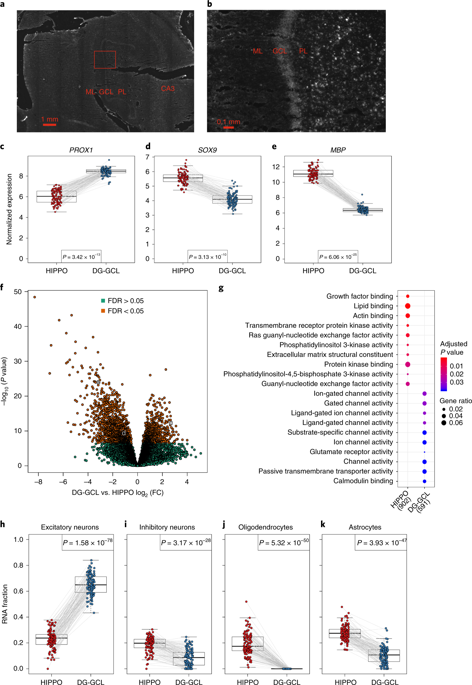Nature Neuroscience ( IF 21.2 ) Pub Date : 2020-03-16 , DOI: 10.1038/s41593-020-0604-z Andrew E Jaffe 1, 2, 3, 4, 5, 6 , Daniel J Hoeppner 1, 7, 8 , Takeshi Saito 7 , Lou Blanpain 1 , Joy Ukaigwe 1 , Emily E Burke 1 , Leonardo Collado-Torres 1 , Ran Tao 1 , Katsunori Tajinda 7 , Kristen R Maynard 1 , Matthew N Tran 1 , Keri Martinowich 1, 5, 6 , Amy Deep-Soboslay 1 , Joo Heon Shin 1 , Joel E Kleinman 1, 6 , Daniel R Weinberger 1, 4, 5, 6, 9 , Mitsuyuki Matsumoto 7, 8 , Thomas M Hyde 1, 6, 9

|
Specific cell populations may have unique contributions to schizophrenia but may be missed in studies of homogenate tissue. Here laser capture microdissection followed by RNA sequencing (LCM-seq) was used to transcriptomically profile the granule cell layer of the dentate gyrus (DG-GCL) in human hippocampus and contrast these data to those obtained from bulk hippocampal homogenate. We identified widespread cell-type-enriched aging and genetic effects in the DG-GCL that were either absent or directionally discordant in bulk hippocampus data. Of the ~9 million expression quantitative trait loci identified in the DG-GCL, 15% were not detected in bulk hippocampus, including 15 schizophrenia risk variants. We created transcriptome-wide association study genetic weights from the DG-GCL, which identified many schizophrenia-associated genetic signals not found in transcriptome-wide association studies from bulk hippocampus, including GRM3 and CACNA1C. These results highlight the improved biological resolution provided by targeted sampling strategies like LCM and complement homogenate and single-nucleus approaches in human brain.
中文翻译:

分析人类齿状回颗粒细胞层中的基因表达,揭示了对精神分裂症及其遗传风险的见解。
特定的细胞群可能对精神分裂症有独特的贡献,但在匀浆组织的研究中可能会被遗漏。在这里,激光捕获显微切割和 RNA 测序 (LCM-seq) 用于转录组分析人类海马齿状回 (DG-GCL) 的颗粒细胞层,并将这些数据与从大量海马匀浆中获得的数据进行对比。我们在 DG-GCL 中发现了广泛的细胞类型丰富的衰老和遗传效应,这些效应在海马体数据中不存在或方向不一致。在 DG-GCL 中鉴定的约 900 万个表达数量性状基因座中,15% 未在海马体中检测到,包括 15 种精神分裂症风险变异体。我们从 DG-GCL 创建了全转录组关联研究遗传权重,GRM3和CACNA1C。这些结果突出了目标采样策略(如 LCM)以及人脑中的补体匀浆和单核方法提供的改进的生物分辨率。











































 京公网安备 11010802027423号
京公网安备 11010802027423号